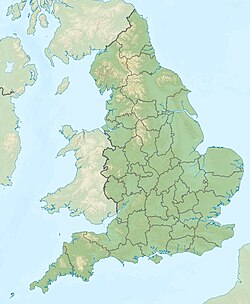
Back Plymouth Afrikaans Plymouth ALS Plymouth AN Sūþtun on Defnum ANG بليموث Arabic بليموث ARZ Plymouth AST Plimut Azerbaijani Плімут Byelorussian Плімут BE-X-OLD
Plymouth (/ˈplɪməθ/ ⓘ PLIM-əth) is a port city and unitary authority in Devon, South West England. It is located on Devon's south coast between the rivers Plym and Tamar, about 36 miles (58 km) southwest of Exeter and 193 miles (311 km) southwest of London. It is the most populous city in Devon.
Plymouth's history extends back to the Bronze Age, evolving from a trading post at Mount Batten into the thriving market town of Sutton, which was formally re-named as Plymouth in 1439 when it was made a borough. The settlement has played a significant role in English history, notably in 1588 when an English fleet based here defeated the Spanish Armada, and in 1620 as the departure point for the Pilgrim Fathers to the New World. During the English Civil War, the town was held by the Parliamentarians and was besieged between 1642 and 1646. In 1690 a dockyard was established on the River Tamar for the Royal Navy and Plymouth grew as a commercial shipping port throughout the Industrial Revolution.
After absorbing nearby settlements in 1914, the borough was awarded city status in 1928. During World War II, Plymouth suffered extensive damage in the Plymouth Blitz, leading to post-war rebuilding that significantly shaped its modern appearance. A further expansion of its boundaries in 1967 contributed to its current status as the 30th-most populous built-up area in the UK and the second-largest city in the South West after Bristol, with a population in 2022 of 266,862.
Plymouth's economy, historically rooted in shipbuilding and seafaring, has transitioned towards a service-based economy since the 1990s. It maintains strong maritime connections, hosting HMNB Devonport, the largest operational naval base in Western Europe, and offering ferry links to Brittany and Spain. The city is also home to the University of Plymouth, reflecting its educational and cultural significance. Today, the city is governed locally by Plymouth City Council and is represented nationally by three[4] Members of Parliament.
Remains of Homo sapiens have been found in local caves,[5] and artefacts dating from the Bronze Age to the Middle Iron Age have been found at Mount Batten,[6] showing that it was one of few principal trading ports of pre-Roman Britannia dominating continental trade with Armorica.[7] An unidentified settlement named TAMARI OSTIA (mouth/estuaries of the Tamar) is listed in Ptolemy's Geographia and is presumed to be located in the area of the modern city.[8] An ancient promontory fort was located at Rame Head at the mouth of Plymouth Sound[9] with ancient hillforts located at Lyneham Warren to the east, Boringdon Camp[10] and Maristow Camp to the north.[11]
The settlement of Plympton, further up the River Plym than the current Plymouth, was also an early trading port. (See Plympton for the derivation of the name Plym.) As the river silted up in the early 11th century, mariners and merchants were forced to settle downriver, at the current day Barbican near the river mouth.[12] At the time this village was called Sutton, meaning south town in Old English.[12] The name Plym Mouth, meaning "mouth of the River Plym" was first mentioned in a Pipe Roll of 1211.[13] Plympton Priory owned land at Sutton and secured a charter from Henry III in 1254 granting the priory the right to hold a weekly market and annual fair at Sutton, making it a market town.[14]
- ^ Cite error: The named reference
brief historywas invoked but never defined (see the help page). - ^ "Mid-Year Population Estimates, UK, June 2022". Office for National Statistics. 26 March 2024. Retrieved 3 May 2024.
- ^ UK Census (2021). "2021 Census Area Profile – Watford Local Authority (E07000103)". Nomis. Office for National Statistics. Retrieved 5 January 2024.
- ^ "MPs | PLYMOUTH.GOV.UK". Plymouth City Council. Retrieved 22 August 2024.
- ^ Andrew T. Chamberlain; Keith W. Ray; Charlotte Henderson; Richard Welton Fisher (1994). A Catalogue of Quaternary Fossil-bearing Cave Sites in the Plymouth Area. Plymouth City Archaeology. ISBN 1-85522-345-7.
- ^ Historic England. "Mount Batten (1017598)". National Heritage List for England. Retrieved 30 March 2019.
- ^ Cunliffe, Barry (2004). "Britain and the Continent:Networks of Interaction". In Malcolm Todd (ed.). A Companion to Roman Britain. Blackwell Publishing. p. 3. ISBN 0-631-21823-8. Archived from the original on 23 July 2021. Retrieved 23 June 2008.
- ^ Denis Larionov & Alexander Zhulin. "Read the ebook Geographia classica, or, The application of antient geography to the classics by Samuel Butler". Ebooksread.com. Archived from the original on 21 May 2013. Retrieved 17 September 2012.
- ^ "Rame Head". Archived from the original on 16 October 2017. Retrieved 16 October 2017.
- ^ "Wasteberry Camp". Archived from the original on 17 October 2017. Retrieved 16 October 2017.
- ^ "Atlas of hillforts of Great Britain and Ireland". Hillforts.arch.ox.ac.uk. Retrieved 19 July 2022.
- ^ a b "The early history of Plymouth". Plymouth City Council. Archived from the original on 9 June 2008. Retrieved 19 July 2008.
- ^ Gill, Crispin (1979). Plymouth, A New History. Newton Abbot: David and Charles. ISBN 978-0-7153-7617-1. (Quoted in Moseley, Brian (2 January 2011). "Plymouth – a History". The Encyclopaedia of Plymouth History. Plymouth Data. Archived from the original on 24 October 2013. Retrieved 13 February 2015.)
- ^ Mitchell, Neill (March 2012). "The day Plymouth opened for business 27th January 1254". Old Plymouth Society. Retrieved 13 August 2023.












